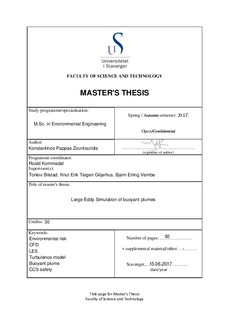| dc.contributor.advisor | Bilstad, Torleiv | |
| dc.contributor.advisor | Teigen Giljarhus, Knut Erik | |
| dc.contributor.advisor | Vembe, Bjørn Erling | |
| dc.contributor.author | Pappas Zountouridis, Konstantinos | |
| dc.date.accessioned | 2017-10-04T11:56:05Z | |
| dc.date.available | 2017-10-04T11:56:05Z | |
| dc.date.issued | 2017-06 | |
| dc.identifier.uri | http://hdl.handle.net/11250/2458384 | |
| dc.description | Master's thesis in Environmental technology | nb_NO |
| dc.description.abstract | Industrial and environmental safety relies on understanding and evaluating risks and failures on the individual processes and operations. Simulating hazardous fluid flows with the use of Computational Fluid Dynamics (CFD) software is an accepted technique to assess consequences, and construct protective barriers in case of a negative event.
Some well-documented flow scenarios with significant properties that need to be further investigated are the buoyancy-dominated plumes, and the multiphase flow from a high pressure liquid CO2 release. The model that will mimic the turbulence in the system is one of the numerous parameters to be considered when conducting a a fluid flow simulation.
This project focuses on evaluating Large Eddy Simulation (LES) turbulence models in the buoyant plumes. The models depend on different filtering techniques for the eddy resolution (temporal and spatial), and the goal is to recognize the main factors and challenges affecting such simulations, by comparing numerical to experimental data.
Three different test cases are simulated, one thermal plume, one helium plume, and one CO2 release. In the thermal plume case, the numerical and the experimental data are closely matching, while for the helium plume the models overpredict the experimental data. The numerical data for CO2 give insights into a high pressure release from a pipeline rupture, which can be encountered in Carbon Capture and Storage (CCS) infrastructures. Apart from the choice of the turbulence model, imposing random fluctuations in the inlet of the flow, the grid scale of the setup and the writing interval of the time-averaged data are distinguished as key features with large impact on the simulation efforts. | nb_NO |
| dc.language.iso | eng | nb_NO |
| dc.publisher | University of Stavanger, Norway | nb_NO |
| dc.relation.ispartofseries | Masteroppgave/UIS-TN-IMN/2017; | |
| dc.rights | Navngivelse 4.0 Internasjonal | * |
| dc.rights.uri | http://creativecommons.org/licenses/by/4.0/deed.no | * |
| dc.subject | CFD | nb_NO |
| dc.subject | LES | nb_NO |
| dc.subject | CCS safety | nb_NO |
| dc.subject | teknisk miljøvern | nb_NO |
| dc.subject | vann | nb_NO |
| dc.subject | environmental risk | nb_NO |
| dc.subject | turbulence model | nb_NO |
| dc.subject | buoyant plume | nb_NO |
| dc.subject | environmental engineering | nb_NO |
| dc.title | Large Eddy Simulation of buoyant plumes | nb_NO |
| dc.type | Master thesis | nb_NO |
| dc.subject.nsi | VDP::Technology: 500::Environmental engineering: 610 | nb_NO |

